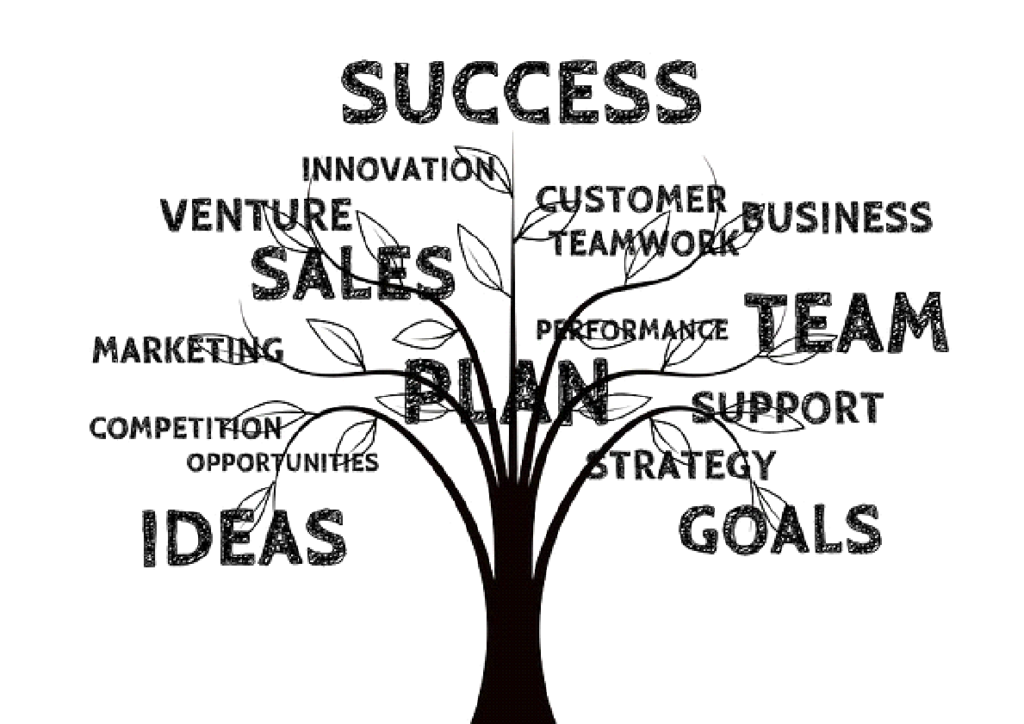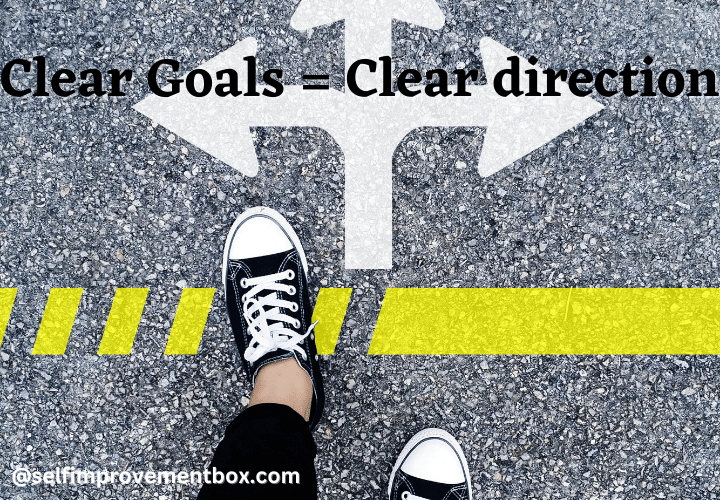Do you have some things you are aiming for in life? You can get them if you set clear objectives and plot a clear direction to them. Let’s explore this topic.
How do goals give you direction?
Goals help us to create a vision of what we want to get done in the days to come putting us on the right path. They ensure our minds and actions are directed toward making our desires a reality.
For example, you could have annual goals you would like to work on to progress in your life. Outlining these tasks will ensure everything makes sense to you, helping you to gain focus.
Are goals good for setting a direction?
You are assured of growth when you set goals because they keep you on a path that improves your character.
While there are many things you can do to set goals and direction in your life, writing your objectives down tops the list.
Doing this stops you from being confused, and helps you to systematically work on your desires which keeps you moving on a path of success.
objectives also help you to avoid actions that will lead to losses from the moment you begin working on your tasks, further increasing your chances of success.
Why is it important to be goal-directed?


Regardless of how excellent you are and how much work you put into doing something, if you do it without planning, it will leave you headed in the wrong direction.
For example, trying to improve yourself without writing down annual goals reduces your chance of succeeding at your objectives.
When you set goals, you get to know whether something matters to you and what you need to get it. It also helps you to learn from your mistakes and put more effort into your work where needed.
Planned objectives also keep you from giving up as you pursue your purpose. That keeps you heading in the right direction, ensuring you achieve great things.
Therefore, you are assured of always finding better ways of working on your tasks, which will always keep you headed in the right direction.
How do goals give us direction?
You can develop distinct ideas and set a solid path to succeed at what you are pursuing by outlining clear objectives.
Deciding to pursue an objective can protect you from destructive behavior. It motivates you to work on your undertakings and keep moving forward toward their completion.
In this way, objectives help you to plot profitable plans and directions based on your reality.
They also ensure you keep doing the right things when working on tasks helping you to keep facing the general direction of success.
Why are direction and goal important?
It would be best if you always consider forward movement when working towards something.
That’s why setting goals while knowing where you are going will make it easier for you to get what you want.
The main reason for this is that objectives give you a precise measure of your successes and failures that helps you to weigh what you get after working at something.
However, you must know why you want to achieve something and what it will get you; then, you can tell whether you are headed in the right direction.
This will save you from losing resources while working on projects.
It will also ensure anyone you involve in your plans moves in a set direction creating efficient teamwork that will bring great results.
What are the 3 types of goals?


Anytime you are working on your goals, there are three types of objectives you should consider, these are process, performance, and outcome goals.
Process objectives are tasks that you work on by following pre-planned steps to get rewards. These steps help you to understand how to complete a task regardless of whether it takes a week or month.
Another type of objective is performance objectives. These are specific goals that help you to answer the question “Are you making progress ?”
You may determine your performance and progress when working on such tasks by measuring your speed at completing assignments. An example of a performance objective is finishing a project at work.
Then there are outcome goals. These are objectives that give you an idea of what to expect when working on tasks. For example when looking for things you are aiming for in life such as a new job.
Outcome goals require you to chart a clear path to your desired outcome with minimum losses on your part in terms of time or resources .
Remember these 3 types of objectives when working on tasks. Find which one fits your plans, and you’ll accomplish your objectives successfully.
What are the three 3 components of a goal?
3 components make up objectives. They outline what it takes to achieve one’s purpose. These are performance, conditions, and criteria.
Performance refers to what you do to complete an objective in terms of actions. For example, if you choose to write a book.
The performance component of your task would be how you intend to write it.
There is also the conditioning aspect of setting an objective that takes into account the circumstances in which you want to work on your ideas.
In the illustration above, you must plan where you will write your book and how much time you will spend on your writing each day.
Criteria refer to how you will work towards your objectives. That will determine the labour and skills you put toward it.
For instance, how will you check for grammatical mistakes in your book? Will you hire an editor or use an online application?
The criteria you choose to work on specific goals can help you measure your efforts when working on an objective.
Considering all these components puts you in the right direction when working on objectives, reducing the mistakes you make along the way.
Create a statement of direction that works for you
Once you know the objectives to concentrate on when working towards achievements, you need a statement of direction.
A statement of direction in goal setting is also referred to as a vision statement.
Writing down a statement of direction to your objectives will help you align your energy with ideas of what you want to attain.
People who invest in your objectives will only help you if they agree with your statement of direction.
Therefore, this statement unites the people involved in achieving a particular goal by ensuring they are all headed the right way.
Set direction, not goals


As you can see, setting directions is the basis of all goal setting. Plotting the directions to specific goals will show you all the tasks you should accomplish to succeed at them.
Writing why you are pursuing these things, what you need to get there, and who to include in your endeavors makes you efficient.
Choosing the direction to take every time you go after something also helps you to intentionally approach issues with solutions in mind.
3 good things about goals
There are some good things about objectives that will always encourage you to pursue them.
One is that objectives help you to realize what you want in life and work towards it. They give you the desire to get out of bed every morning and put your effort into activities that will aid in succeeding at them. For instance, writing a page a day to publish a book.
Secondly, objectives increase the belief you have in yourself. Whenever you diligently put your efforts into something and get great results, it gives you more faith in yourself.
And thirdly, deciding to work on tasks and follow the necessary steps to get what you want gives you control over events in your life. There is a strong feeling that you have the capabilities to finish such tasks and work on others, which boosts your morale.
By functioning with this idea in mind, you proactively approach challenges instead of letting things happen to you. That gives you control over the direction of your life and how it turns out.
How to avoid success or failure scenarios by setting mastery goals
Once you learn to set goals and accomplish them, the next step to take is finding ways to master the expertise necessary to refine your outcomes. This is called mastering tasks through goal setting.
The reality is that every master focuses on excellence and you should too. You may do this by always delivering improved performances in projects.
The best manner of working to apply here is to look at what you have achieved before and find ways of surpassing those outcomes.
You can do this by lowering the time it takes to work on a task from a week to a few days.
There is also the option of using an iterative process where you revise your work until you get a method of working that gives you satisfactory results. Then you can decide to always use this modus operandi to excel in your work.
If you identify the precise methods of achieving success for working on specific goals it will help you to become a master at your profession.
Ongoing satisfaction through goal setting


Do you sometimes feel ill-equipped to work on new tasks? The best way to overcome this feeling is to complete objectives by working on a part at a time.
The feeling of satisfaction you get after succeeding at one aspect of your objective will give you the motivation to handle the other parts.
As humans, we benefit most from the feeling of satisfaction we experience after succeeding at something.
People who are satisfied with the way they handle tasks are likely to perform better in the next one once they’ve achieved success.
Therefore, making piecemeal progress toward what you want is an important part of working on objectives.
You will find it keeps you moving forward by giving you a feeling of continuous satisfaction that translates to amazing contentment in your life.
Once you learn to approach tasks like this, it will keep you from giving up on your objectives when times are hard because you know that you will get your satisfaction at the finish line if you keep on working.
Over-prescribing goal-setting does more harm than good
Although working towards your objectives can contribute to your ongoing satisfaction, focusing too much on targets may slow down your progress.
Some habits that you choose during this time could make work difficult. You may have witnessed people straining their relationships because they spend too much time working.
Such things often happen in organizations with leaders who are too committed to performance objectives.
Their efforts to push workers to deliver exemplary results through performance reviews destroys interpersonal relations and morale among co-workers.
You’ll also find that over-prescribing to setting goals takes away the feeling of autonomous motivation from employees. This happens especially when their superiors are always looking over their shoulders to give them directions.
It gives them a feeling they can only work on tasks when prompted by others forcing them to work under controlled motivation. This type of motivation makes people who are pushed towards goal setting feel less inspired to work on them.
So, it’s essential that we also focus on things that will boost our morale while working on tasks to ensure we live a well-adjusted life that inspires autonomous motivation in us.
Otherwise, you may jeopardize your relationships at work or home because you feel overburdened.
A sign that you are overburdened by goal setting is problems in your relationships. You may also notice that you engage in risky/unethical habits alot when trying to succeed at objectives.
What can you do to avoid this? Try developing an attitude that gives you an inbuilt desire to work on your purpose. It will keep you focused as you struggle through the challenges of working on tasks and assure you of progress and success.
Over-use of performance goals has been shown to harm companies
While performance objectives can improve how employees work, this way of measuring task performance can put an unnecessary strain on your employees.
This often happens when the instructions you give them are too difficult, or they have a short time to work on tasks.
Companies that measure performance should not put undue pressure on employees; otherwise, they will deliver unsatisfactory results.
You will notice this with tasks that require an iterative process to complete. These are tasks that require employees to work on objectives by repeatedly going over their outcomes to improve results.
Unfortunately, the effort employees put into such tasks leaves many of them dissolutioned, disgruntled, and tired.
So, in many cases, employees who have to work on performance targets do not give their best, and this can affect company performance leading to loss of clients.
Therefore, companies should always focus on helping employees to improve their performance.
You may do this by teaching them skills they can use to better their results, such as analysis.
Learning such skills will improve the result you get from your employees helping them to work harder thereby ensuring performance objectives do not harm your company’s output.
Using learned associations in the pre-frontal cortex and basal ganglia to direct behavior toward a goal


There is a region in the brain called the pre-frontal cortex that helps us consciously decide to work on tasks to completion.
For example, when you choose to repair a vehicle from start to finish by, following instructions.
When this region of the brain is not functioning correctly, you don’t change your behavior even when your actions stop giving you the desired outcome.
Your actions become robotic. This often triggers disorders such as obsessive-compulsive disorder.
Another region of the brain that is involved in stimulus-response when working on tasks is the basal ganglia.
It helps you work on tasks requiring habitual learning, such as motor habit control. For instance, when learning a dance routine.
People with malfunctioning basal ganglia have difficulty associating a stimulus with a specific outcome when performing tasks.
You can use learned associations in the pre-frontal cortex and basal ganglia to direct behavior when working toward a purpose if you respond to their stimulus.
Their interaction creates an iterative process that controls your learning process as you work towards your objectives.
If you respond to changing pre-frontal cortex and basal ganglia stimuli, you will avoid repeating actions that only bring the same end result.
That will help you get better outcomes every time you work on a task keeping you focused on your objective to completion.
Computational role of recurrent cortico-ganglia loops
The basal ganglia and pre-frontal cortex work as integrated systems through a recurrent connection referred to as cortical-ganglia loops.
This connection eases communication between both cerebral areas and ensures the information you learn in one area of the brain is forwarded to the other.
In these recurrent cortical ganglia loops, neurons in the brain are activated at each stage of your behavioral task process. They are stationed at the point at which you make a decision or when you are prompted to work towards a reward.
What you do at the two points of reward or decision-making forms habits that determine how you pursue objectives and the results you get.
If the outcomes of an action are beneath your expectations, you will miss the rewarding feeling of succeeding at something and learning from it.
That should inspire you to try performing the action again using a step – by- step approach until you get the desired outcome.
In this way, recurrent cortico-ganglia loops can help you to improve your performance and create beneficial work patterns.
Learning complex task structures
Once you learn how recurrent loops work, you should master the workings of complex task structures.
These are integrated structures that enable us to work on tasks knowledgeably.
These structures help us coordinate our attitudes, skills, and know-how when working on tasks.
They bring our vision together, enabling us to plan a clear path to our targets.
Complex task structures run from top to bottom in a model you may liken to a tree.
Each branch in the tree represents an action you should take to accomplish your aims.
You should only move forward to the following action if you complete the previous one and profit from it.
Think of it like climbing a tree branch by branch. Only rewards for your exertion motivate you to reach for the next branch, which is the next task.
During this learning process, what you decide to do after every move is determined by what you learn from the previous one.
For example, you may decide to go shopping and check your grocery store website for offers before leaving the house.
What you learn from that search will help you to write down a list of affordable grocery items.
Therefore, when working with task structures, the most essential factor is analyzing your objectives from the first step to the last one to make a path that will push you forward to success.
Forget about goals – fall in love with a system instead


By looking at task structures, you can see that while objectives are a great way to complete an objective, it’s better to put your energy into systems for long-term success.
Objectives are only useful for pointing you in the general direction of what you want. They usually help when accomplishing single tasks that give temporary results.
A systematic approach is quite different; it gives lasting results, especially when working on long-term tasks.
For instance, when you set an objective to design a website. Following step-by-step instructions when working on your website will form a systematic memory that will help you to work on others.
In this way, working with systems is better than depending on objectives. They help you form lasting habits or skills and elevate your thinking, ensuring you maintain forward movement.
The benefits of system-oriented goals
System objectives are tasks you work on daily on the way to a bigger purpose. They are preferable to goals which are things you want to achieve at a later date.
Working on tasks systematically motivates you to learn something every day to push you toward your objective.
Pursuing system objectives also helps you to make thoughtful and accurate plans to help you succeed at complicated tasks.
That will help you to get things done efficiently, giving you a break from the struggle that often characterizes most projects.
System-oriented objectives also help us to work on a timeline keeping us from wasting time when engaging ourselves in any activity to accomplish an objective.
We can also use them to refine our decision-making skills because we work on them every day.
In this way, working with systems rather than goals gives people a lasting solution to problems.
Plan your systems based on the assumption of hardship
When dealing with systems to attain objectives, you have to assume there will be some hardship along the way.
Therefore, you should use assumption-based planning to cushion yourself from these potential problems.
That means outlining all your assumptions on what you think will go wrong as you work on your task and finding solutions for them.
For instance, you may assume you’ll sell a certain amount of goods within a fixed period.
It’s critical that you factor in some obstacles in your plans that will keep you from moving forward with your task.
For example, a reduction in demand due to flooding in the market.
You should consider what solution you can include in your system to overcome this challenge? You may find clients beforehand who will buy the goods from you.
In this way, assumption-based planning will help you to set a clear direction for dealing with any problems you experience when working on a task.
Using assumption-based planning in this way will put you in the proper direction when working on an objective, regardless of what outcome you get. It helps to minimize the energy and time it takes to make your dream a reality no matter what happens.
Working on system-oriented goals
System objectives are tasks you set to work on something through purposeful actions.
They help you to decide which habits are useful when solving a problem.
This type of objective necessitates the collection of data and analysis of it when working on tasks. This happens to get the best way to achieve an objective.
An example of a system goal is starting and running a business.
The first thing to focus on when working on such a task is outlining the hows, wheres, and whats of achieving your purpose.
You will find that writing down these points will give you a comprehensive view of your end result and help you to identify any problems you may encounter.
Then you can choose more profitable ways of achieving your task and include them in your system plan.
Solving issues in this way will give you progressive control of any problem you encounter.
Something that will make it easier to succeed at your system objectives is the type of thinking you use to find solutions. The options available are fast and gradual learning.
Fast learning limits your understanding of what is going on as you work on system tasks to what you can identify with your five senses. That refers to what you can see, hear, smell, taste, and feel.
This type of learning is best suited to dealing with simple tasks. For example, setting up your business display.
Gradual learning is better for working on long-term objectives because it helps you to break down your objectives into manageable sizes.
That will help you to analyze the many situations that come up as you work on your objective, giving you an idea of how to solve problems you identify on the way.
If you approach system objectives using these two forms of thinking, it will make a significant difference in the way you work on your goals in life, making you a better person.
You will also find that working with system objectives helps you to avoid goals restricting behavior and identify profitable solutions to apply in different situations that come up as you pursue your long-term objectives.
Projecting into the future a proposed neural mechanism for task-directed behavior


You can increase your chances of completing your objectives further by projecting your vision of success into the future.
The best way to do this is by writing down your plans and visualizing how you will bring them to fruition.
When you imagine yourself working at an objective, it activates the visual cortex helping you to predict outcomes.
Working on your ambitions in this way also gives you a sense of how things will turn out preparing you for any eventuality.
You can learn simple task-directed actions to help you succeed at the objectives you visualize through the basal ganglia.
Your pre-frontal cortex will then help you to adapt behaviors that will help you to commit to your tasks over the long term.
The interaction between these two neural mechanism systems is complementary. Together, they control the process of working at an objective from top to bottom.
Responding to their learning stimuli will ensure your projections become a reality if you work on your objectives one task at a time.
Interactions between learning in the pre-frontal cortex and basal ganglia
As you’ve seen, the pre-frontal cortex and basal ganglia control how we learn when working on our objectives .
The pre-frontal cortex helps you to gradually work on complex tasks that require a long-term commitment.
For example, going through a driving course to attain your objective of getting a driving license.
This is something that will require you to master several tasks before you succeed, such as learning road rules and signs and mastering how to handle a car on the road.
On the other hand, the basal ganglia helps you to perform simple tasks, such as cooking a meal using a recipe.
It enables you to work on each step as described in the recipe until you finish cooking the meal giving you a feeling of short-term satisfaction.
Your brain uses the basal ganglia and pre-frontal cortex to control the flow and command of behavior that is involved in setting goals and working on them when dealing with short and long-term objectives.
These two parts of your brain ensure the knowledge you get in the first step of working towards your objective will help you to plan the next move.
That gives you comprehensive control of your plans to help you accomplish a task. It also makes a perfect environment for you to make sense of any problems you encounter and find solutions.
Gradual learning in the pre-frontal cortex; fast learning in the basal ganglia
The good thing about learning how the pre-frontal cortex and basal ganglia work when pursuing objectives is the behavior you adopt from the process.
It gives you a sense of what to expect from every action you take toward achieving an objective which helps you in making decisions.
When you get dis-satisfactory outcomes from an action, your associations of it with rewards are weakened, prompting you to break away from it.
As authors like James Clear, who champion the creation of habits, state, we always gravitate towards behavior that triggers reward signals.
When your brain keeps reinforcing the association of rewarding outcomes with actions, these reward signals act as teaching signals.
You may use them to gradually learn how to accomplish a long-term objective through the pre-frontal cortex and the basal ganglia.
However, there is a difference in learning speeds between the basal ganglia and pre-frontal cortex.
You learn simple lessons quickly through the basal ganglia, while you can only internalize long-term learning mechanisms through the pre-frontal cortex.
The combined action of these two parts of the brain helps you to work on big tasks by taking small steps at a time. These steps can help you accomplish long-term objectives successfully.
The neural mechanisms of fast versus gradual learning
You can see that the most important factor to focus on when charting a clear direction toward your objectives is learning.
It helps us to internalize the knowledge we get through our experiences while working on tasks, giving us a firm sense of how to accomplish objectives.
We access this material in the course of working on tasks from neural mechanisms of learning that are regulated by the pre-frontal cortex and basal ganglia.
The behavior you adopt when working on tasks comes as a result of the learning tempo you adapt from these two parts of your brain. These are fast and gradual learning.
The process of working on short-term tasks is managed through fast learning in the basal ganglia.
We depend on the pre-frontal cortex, which controls gradual learning when accomplishing long-term objectives.
Gradual learning helps you to work on objectives thoroughly and gives you a better understanding of the systems involved.
The faster you master problem-solving skills in the course of working on tasks, the easier it will be to accomplish them. That will free – up your brain to work on other tasks.
All this depends on your response to stimuli from your brain, which are reward teaching signals from the pre-frontal cortex and basal ganglia.
If you learn to only pursue actions that reward you when working on your purpose, you will set clear goals and directions to succeed at your objectives.



